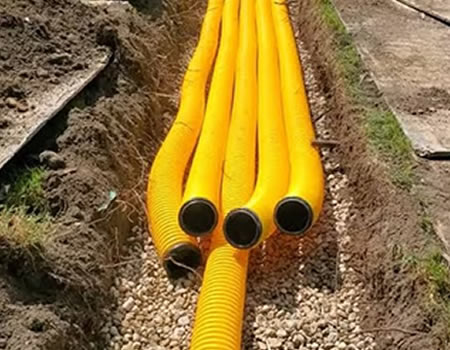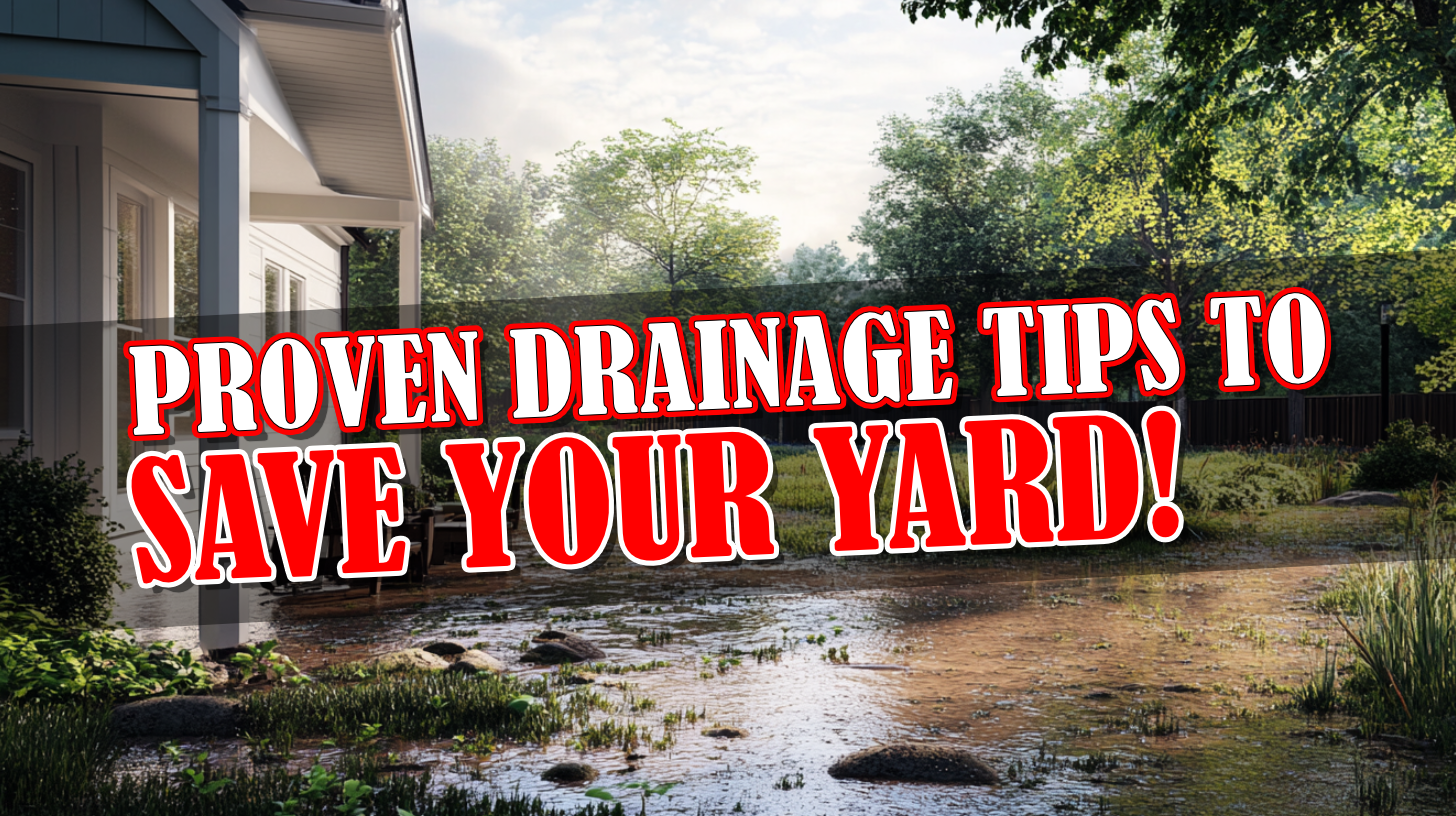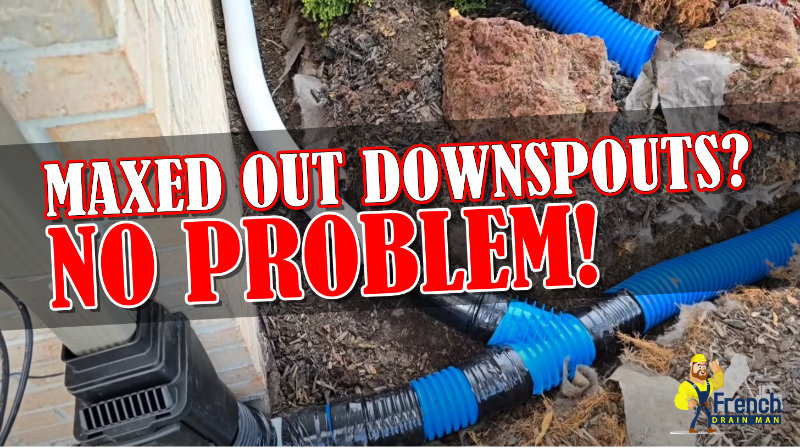How to Build a Leach Field for Yard Drainage Systems – Episode 1/5
 What do you do when you live in a beautiful neighborhood with rolling hills? You found your dream home. It’s the school district that you want your children to go to, but however, as time plays out, you find you happen to be on the street where the homes are the lowest. Look at the elevation change here in this drone footage. You can see the yellow pipe where we’re working. That’s Baughman Knife Cut. I’m going to teach you how to do leach fields and we’re going to put together a series of videos to get you guys there. You’ve been asking a lot of questions and I know our subscribers are ready for it. The DIY wants to know what do I do when I don’t have a storm drain to take my yard drain system to or my sump pump discharge line to. And I’m going to show you in video series and what you can do when your storm drain gets overwhelmed.
What do you do when you live in a beautiful neighborhood with rolling hills? You found your dream home. It’s the school district that you want your children to go to, but however, as time plays out, you find you happen to be on the street where the homes are the lowest. Look at the elevation change here in this drone footage. You can see the yellow pipe where we’re working. That’s Baughman Knife Cut. I’m going to teach you how to do leach fields and we’re going to put together a series of videos to get you guys there. You’ve been asking a lot of questions and I know our subscribers are ready for it. The DIY wants to know what do I do when I don’t have a storm drain to take my yard drain system to or my sump pump discharge line to. And I’m going to show you in video series and what you can do when your storm drain gets overwhelmed.
Welcome until the French drain man channel. I’m Robert Sherwood and I’m here with Scott Francisco, Marcello Valentine, the veteran crew that you guys have been following for the last few years. We’re going to show you today how we use the Baughman Knife Cut, which I will show you that in a clip that I did prior to the field here. This is the drought season here in Michigan, late August. So we had July and all of August. And this is still a swamp. During the wet season and I been here for it, this is just a pooling mess. It’s unbelievable. So we’re going to show you how we take a sump pump discharge line and how we take care of the water. Stay tuned.
We’re not going to cut my fish cable as we did at that one house, man. All right, so we just had to track this because this sump line zig and zagged that did not take a straight line. So we’re good to go and onto the next part.
What we did is we went upstream on the sump pump discharge line and we removed probably half of it so that we had the distance to lose the water in the leach field that we’re going to construct, which I will be showing you in these videos.
Every lot that we install a yard drain system for, whether it’s for their downspouts, floodwater high water table, sump pump discharge line. I always check the soil. I want to see how it percs. We do a perc test. I also will pull a plug and I’ll show you the tool that I use for that. I’ll pull a couple of feet and I’ll be able to see what I have here. I knew that up this far in the yard, we had a really good say 16 inches I believe it was. When you got to the back over here. We actually dug right there and did a test hole and it was just all clay and that’s why this just sat. That’s why the water would go nowhere.
When you try to discharge your sump pump line and you’re asking the water to basically be absorbed by the subsoil in a high concentration, it’s just not going to happen. It has to be dispersed over a very, very long area and you really do need to engineer some sort of leach field that has a reservoir large enough to hold bulk water and let it leach over time.
Obviously we have some good soil here at the surface but we get in the clay after that 16 inches. This is going to be a fun one for you, the DIY and the contractors out there and I do want to mention, I realize that for the homeowner, you know some of this stuff we’re starting to show you now is getting to be a little more advanced. I understand that and what we can do in a day would take the DIY guy a lot longer, many weekends probably. You’d actually probably need to know a contractor that had some equipment to make it worth your while unless you are just a true do it yourself or where you loved to be hands-on, you know, boots in the dirt and I know a ton of you guys. We have a lot of subscribers like that. That describes a lot of our subscribers and we love you for that. We do cause we have that in common.
We’re doing a vertical well right here. I’m going to get some perc out of this. It’s going to work out really well and then it’s going to have an overflow into a horizontal leach field. This is again, you know, starting to get to where you need equipment. You’re hauling out a lot of soil, you’re bringing in a lot of drainage stone and we’re introducing a new pipe. We’re going to show you guys what we’ve been doing. Everybody keeps saying you never show us the leach fields. Only when they’re done, you show it. We see a green lid in the grass and you say that leach field is over there and you’re absolutely right. I really haven’t been showing that for a few reasons. One, it again, you need more equipment, more material, more haul out. It’s more advanced. But I did promise you that this year we are gonna take you to the next level and we’re going to show you more.
So, Scott, he knows how to do this. I mean he’s being patient with that so that we don’t break anything and he’s just easing it along. We’re starting to get down in the clay and that’s going to be a problem. Scott’s a pro at this. Do you see how he pulls that out? He doesn’t keep it spinning so that he can shake the dirt off on plywood. You can tell that this crew has done this hundred of times. I mean, this is just, this is perfection. This is just perfection. We don’t have to rehearse for this. The guys, I just show up and I start making videos for you and they just do their job. That’s it. I mean right now, you know, they’re just kind talking, you know, casual, you know, this is like water cooler talk for them and you know, they know that the real work is yet to come. The machine right now is doing the bulk of the work and Scott’s trying to get this down to depth. We like to get it to 48 inches because then that way the frost can’t get underneath this vertical. It’s basically what you guys would call a dry well, but it’s going to go out to a leach field.
So Scott’s over here. This soil’s so rocky. It’s, there’s so much rock now and we have to just take it easy so that we don’t break anything. You can see Scott shuts the auger off and he raises it. That’s a veteran move. I’ve, I see the rookies, what they’re doing, they’re spinning dirt, they’re spinning dirt, they’re spinning dirt, they’re spinning dirt. They lift this thing up and the dirt slinging off and falling back in the hole. So Scott knows how to run the hydraulics on this. He can feather it, he can get it you know, he can make this machine do anything. I mean, it’s just amazing. These guys work with this equipment every day. It’s like an extension of their body.
There are so many rocks in this clay. This is really a grinding vertical drop that we’re creating here. I mean, normally we can blow a four-foot vertical drop in. We could just Scott and the guys I’ve timed them were six minutes, boom. Believe it or not, ready for a crock. That’s how quick it is when you don’t have these big look at that. That’s four or five inches. Five-inch cobble rock. Yeah. I mean that’s some big stuff. And they’re down in the clay now too. So s look at that. He’s got all that dirt. I mean, there’s got to be a wheelbarrow of dirt there and he’s just piling it up.
So these are things that can help the DIY when you rent this equipment because obviously you’re getting familiar with the equipment and you need to do multiple jobs to run the equipment like this. And honestly, you needed to be running it for years to actually know the things that Scott knows. I mean, Scott, he came in, he and I started working together when he was 17. Today in this video, he’s 45 so I mean this guy is a veteran and when it comes to machine operating, there’s nobody better. So I’ve had guys break this auger multiple times rookies, and we just don’t even let them run anymore for that very reason.
Now that skidder, that little mini loader, that has a diesel that’s turbo-powered and man, when that turbo, when it winds up, it can break implements. It’s a powerful machine. So that would be Ditch, Witch’s 1050, sk1050 equivalent. At the time there was an sk850 and then when they upped it, they called it an 850 Plus, which later now they’re slapping a decal on it that you know t’s an sk1050 so that, you know. So guys, if you’re looking for something with some muscle, that’s the machine you want.
So we’re down in the clay, they are removing the cobble, and this is a hard dig. Scott could tell something wasn’t right, he could feel it. And the guys are trying to remove, five-inch cobble rocks in clay and they looked like they were just holding up shovels, but they’re working, they’re working pretty hard there, that’s for sure.
So like I said, the real works, you have to come here, but this is a job in Rochester, Michigan. Unfortunately, the street, this home is so much lower than the street out front that all the water comes running. I mean, he has a channel drain across his driveway. There are so many things here. He’s been battling water the whole time that he’s lived here. So this is gonna be basically the last piece of the puzzle to straighten out all his water problems. You know, you asked me, is this overkill? I said, absolutely not. Because once we get into the rainy season and this sump line is highly active, we’re going to fill this vertical drop and we’re going to fill that leach field.
This is a pretty fun job for contractors like us. You know the stuff we’ve been showing you guys, that’s some boring stuff to us. Just running something to a storm drain catch basin. That’s not exciting. That doesn’t get our blood boiling. But you know, we love stuff like this. This one was fun and we did it in a day. I can’t say exactly what time we checked out here, but I want to say we were, we were done by about four and the job went smoothly because you know, this is something that we do routinely.
I’m going to take you to see another situation in Bloomfield, Michigan. And the difference there is there’s no storm drain at this house. You’re going to see a bigger leach field that’s more advanced at this house. When we go to Bloomfield, there is a storm drain. But here’s the catch, during flash floods, the storm drain can’t keep up and that presents a problem. So we got to build a system that not only catches all the water, but we got to build a system that is a large reservoir. So this meant a lot of dirt, haul out, a lot more stone brought in. And now again, this is asking a lot of a DIY project. So do know that and I know you’re capable of it. I know we got some, we got some DIYers that are more than capable of it. But for some of you who watch these videos and you wonder, can I do this? These two systems here, you gotta be committed. You’ve got to be fully committed.
All right, so here’s an example of what you need. That was a truck and a dump trailer that was full of clay and they all came in with stone. Dump truck dump trailer came in with stone leaving with clay. You know, we roll up here, we got a 35-foot gooseneck, you know, two minis. Then we have our excavator, the mini excavator, two mini skids. Two pallets of plywood. Scott’s got to pull that with his dually. And this is the home that we’re working at. We’re going to put Baughman Knife Cut in the ground in the front yard in a leach field. I was pulling the thing, it’s a 20-foot gooseneck dump that was full of clay our tool trailer. We brought in stone on this a dump truck and we hauled out clay with it.
So we did this job in a day. This one here did roll until about seven o’clock at night. We rolled out of here late. So I’m going to show you two systems and as I said, these are more advanced. I’m not saying the DIY can’t do them, but I’m saying it does take this kind of equipment. So you know a system like this, this would be a DIYers I’ll say a month of coming home from work and their weekends. You might want to actually, you know, hire to have the stone delivered and then literally pile up the clay and the in the bottom of the driveway. And then you can hire a contractor with a skid loader to come and haul it away for you. That’s not bad. And then you know, you save a ton of money. And if you’re a true DIYer, you believe that the only way it’s going to be done the way you want it is if you do it yourself. I know how DIYer’s are wired, and that’s totally cool. And to a certain extent, you’re absolutely right. It doesn’t mean if you had it hired out that it’s not gonna work. You know, I, I know there’s a lot of competent contractors out there. When we get back to episode two, I’m going to show you what’s going on in this backyard.
All right DIYers, until next time, let’s just try to do it right the first time.
Watch How to Build a Leach Field for Yard Drainage System Episode 1 – 5
- How to Build a Leach Field for Yard Drainage System – Episode 1/5
- How to Build a Leach Field for Yard Drainage System – Episode 2/5
- How to Build a Leach Field for Yard Drainage System – Episode 3/5
- How to Build a Leach Field for Yard Drainage System – Episode 4/5
- How to Build a Leach Field for Yard Drainage System – Episode 5/5








